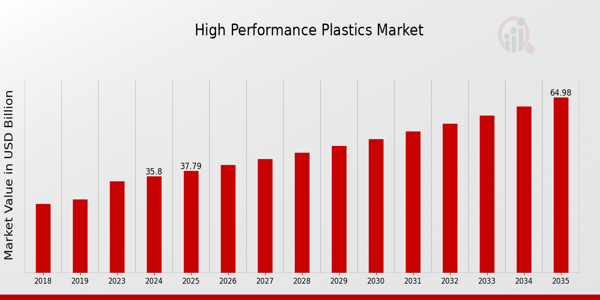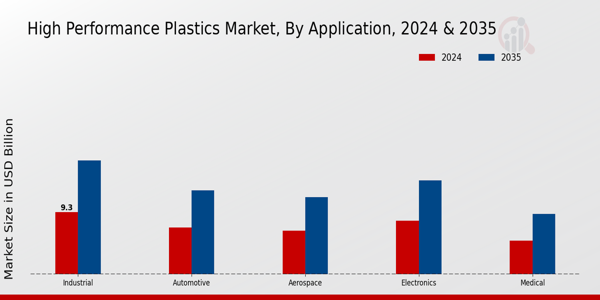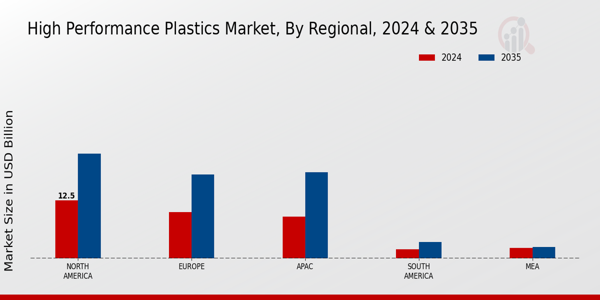Global High-performance Plastics Market Overview
The High-performance Plastics Market Size was estimated at 33.91 (USD Billion) in 2023. The High-performance Plastics Industry is expected to grow from 35.8(USD Billion) in 2024 to 65 (USD Billion) by 2035. The High-performance Plastics Market CAGR (growth rate) is expected to be around 5.57% during the forecast period (2025 - 2035).
Key High-performance Plastics Market Trends Highlighted
The High-performance Plastics Market is currently experiencing substantial trends that are indicative of the transformations occurring in a variety of sectors. The growing demand for lightweight materials in the automotive, aerospace, and electronics sectors is one of the primary market drivers. High-performance plastics are increasingly preferred due to their superior strength-to-weight ratio as companies prioritize fuel efficiency and emissions reduction. In addition, the demand for these materials is increasing as a result of the expansion of renewable energy technologies, including solar and wind power, which are characterized by their exceptional thermal and chemical resistance. The market is experiencing a growth in opportunities as processing technologies continue to improve, making High-performance Plastics more cost-effective and accessible.Innovative applications are being investigated by industries, particularly in the fields of consumer electronics and medical devices, where high durability and performance are essential. The trend toward sustainable manufacturing processes is also influencing the market, as companies are seeking eco-friendly alternatives. This change offers the potential to create biodegradable high-performance plastics that are both environmentally conscious and compliant with regulatory requirements. In recent years, there has been a discernible trend toward increased investments in R to enhance the properties and functionalities of high-performance plastics. Diversified applications are being stimulated by the emphasis on the development of novel materials that exhibit improved resistance to heat and corrosion.

Source: Primary Research, Secondary Research, MRFR Database and Analyst Review
High-performance Plastics Market Drivers
Growing Demand from Automotive and Aerospace Industries
The High-performance Plastics Market Industry is witnessing significant growth driven by the increasing demand from the automotive and aerospace sectors. These industries require materials that can withstand high temperatures, resist corrosion and are lightweight, which high-performance plastics can provide. In recent years, organizations like the International Air Transport Association have reported that air traffic has continued to grow, with passenger numbers rising to over 4 billion in 2018 and projected to double over the next two decades.This surge in air travel necessitates the use of advanced materials, like high-performance plastics, to improve fuel efficiency and reduce emissions in aircraft. The automotive sector is similarly evolving, with an increased focus on electric vehicles, leading to innovative uses of high-performance plastics to reduce vehicle weight and enhance energy efficiency. This trend aligns with broader environmental initiatives globally that aim for a 45 percent reduction in greenhouse gas emissions by 2030 as agreed upon under various international climate accords.
Advancements in Manufacturing Processes
Technological advancements in manufacturing processes significantly contribute to the growth of the High-performance Plastics Market Industry. The development of additive manufacturing technologies, particularly 3D printing, has revolutionized the way high-performance plastics are produced, allowing for higher precision and reduced waste. According to the National Institute of Standards and Technology, the additive manufacturing market is projected to reach over USD 35 billion by 2025, indicating a shift towards more innovative manufacturing solutions.Innovations such as injection molding and extrusion technologies have improved the scalability of producing high-performance plastics, making them more accessible to various industries. These advancements facilitate the production of complex geometries that were previously unfeasible with traditional methods, thus driving the adoption of high-performance plastics in various applications globally.
Increasing Regulatory Support for Sustainable Materials
There is a remarkable increase in regulatory support for sustainable materials and practices that are boosting the High-performance Plastics Market Industry. Governments worldwide are imposing stringent regulations aimed at reducing carbon footprints and promoting the use of environmentally friendly materials. For instance, the European Union has introduced the Circular Economy Action Plan, which aims to encourage the use of recyclable materials to reduce waste.This regulatory framework encourages industries to shift towards high-performance plastics which can often be made from recycled polymers and are also recyclable themselves. According to the European Environment Agency, over 20 million tons of plastic waste were recycled in the EU in 2018 alone, which supports the need for more sustainable materials in manufacturing. This regulatory climate enhances market opportunities for high-performance plastics that appeal to eco-conscious consumers and businesses alike.
High-performance Plastics Market Segment Insights
High-performance Plastics Market Application Insights
The High-performance Plastics Market has been witnessing substantial growth, particularly evident in various applications such as Aerospace, Automotive, Electronics, Medical, and Industrial. In 2024, the overall market is set to attain a valuation of 35.8 USD Billion, reflecting a robust demand for these advanced materials critical in high-stress environments. The Aerospace application sector alone is predicted to see significant expansion, achieving a market value of 6.5 USD Billion in 2024, with its importance underscored by the need for lightweight, durable materials that enhance fuel efficiency and performance in aircraft manufacturing.Similarly, the Automotive segment, valued at 7.0 USD Billion in 2024, is driven by the growing emphasis on fuel-efficient vehicles and stringent environmental regulations, showcasing the importance of High-performance Plastics in driving innovations in vehicle design and safety features. The Electronics application holds a substantial market share, projected to reach 8.0 USD Billion in 2024, fueled by the increasing miniaturization of devices and the demand for lightweight yet robust materials that can withstand thermal and mechanical stress in gadgets.In the Medical sector, with a valuation of 5.0 USD Billion in 2024, the relevance of High-performance Plastics lies in their biocompatibility and versatility for manufacturing medical devices and pharmaceutical packaging, addressing critical needs in healthcare. The Industrial application, representing a significant portion of the market with a valuation of 9.3 USD Billion, further indicates the diverse usability of High-performance Plastics across manufacturing processes, machinery, and various industrial applications where reliability and performance are paramount.The interplay of these segments not only highlights the growing investment in High-performance Plastics but also reflects broader trends in technology advancements and sustainability efforts across industries, positioning the High-performance Plastics Market as an essential part of future innovation and development across various applications.

Source: Primary Research, Secondary Research, MRFR Database and Analyst Review
High-performance Plastics Market Type Insights
The High-performance Plastics Market, categorized by Type, encompasses several crucial materials, including Polyetheretherketone, Polysulfone, Polyimide, Fluoropolymers, and Engineering Thermoplastics, each contributing to the diverse applications across various industries. By 2024, the overall market is expected to be valued at 35.8 USD Billion, indicative of the rising demand for advanced materials that offer superior mechanical and thermal properties. Polyetheretherketone and Polyimide stand out for their exceptional heat resistance and chemical stability, making them vital in the aerospace and automotive sectors.Meanwhile, Polysulfone and Fluoropolymers are prized for their excellent optical clarity and high-performance characteristics in medical devices and telecommunications. Engineering Thermoplastics are notable for their durability and versatility, catering to sectors ranging from consumer goods to electronics. The increasing focus on lightweight materials to improve energy efficiency and reduce emissions drives market growth, while challenges such as high production costs and stringent regulatory standards present opportunities for innovation. The High-performance Plastics Market Statistics reflect a consistent demand for these materials, highlighting their vital role in advancing manufacturing and technology on a scale.
High-performance Plastics Market End-Use Insights
The High-performance Plastics Market is poised for substantial growth, expected to reach a valuation of 35.8 billion USD in 2024, driven by various End Use applications. High-performance Plastics play a pivotal role in sectors like Consumer Goods, where their durability and design flexibility enable innovative products. The Transportation industry benefits from lightweight and high-strength materials, enhancing fuel efficiency and safety. In Healthcare, these materials are critical for developing advanced medical devices and bio-compatible products.The Electrical and Electronics sector relies on High-performance Plastics for their excellent insulating properties and heat resistance, vital for electronics durability. Additionally, the Construction industry continues to embrace High-performance Plastics to improve safety and longevity in building materials. Overall, the High-performance Plastics Market statistics reveal that these End Use applications not only leverage the unique properties of High-performance Plastics but also reflect the increasing demand for sustainable and efficient materials across industries.As market growth continues, opportunities for innovation and expansion within these segments are becoming more prominent, addressing the evolving needs of consumers and industries alike.
High-performance Plastics Market Processing Method Insights
The High-performance Plastics Market demonstrates robust growth within its Processing Method segment, which is integral for various applications across industries. In 2024, the overall market is expected to be valued at approximately USD 35.8 billion, reflecting increasing demand from sectors such as automotive, aerospace, and electronics. Notably, Injection Molding remains a key technique due to its efficiency and ability to produce complex shapes, while Extrusion is favored for continuous production, especially in creating profiles and films.Blow Molding is significant for manufacturing hollow parts and containers, enhancing versatility in product design. Thermoforming attracts attention for its capability to produce large components quickly at a lower cost, providing an attractive option for high-volume production needs. Furthermore, 3D Printing is gaining traction due to advancements in technology, offering customization and rapid prototyping. The High-performance Plastics Market statistics suggest that these processing methods collectively contribute to market dynamics, driven by the demand for lightweight, durable, and high-performance materials, while also confronting challenges such as material costs and environmental considerations.Market growth opportunities lie in the ongoing innovations and the expanding applications of high-performance plastics across various sectors globally.
High-performance Plastics Market Regional Insights
The High-performance Plastics Market is witnessing robust growth across various regions, with a total market valuation of 35.8 USD Billion in 2024. North America holds a substantial share with a value of 12.5 USD Billion, reflecting its advanced industrial base and significant demand in aerospace and automotive sectors. High-performance Plastics are integral to innovation and performance enhancement. Europe follows closely with a valuation of 10.0 USD Billion, driven by stringent regulations favoring lightweight materials in transportation and energy sectors.The Asia-Pacific (APAC) region, valued at 9.0 USD Billion, is emerging rapidly as a manufacturing hub, capitalizing on low labor costs and increasing demand for electronics and consumer goods. Meanwhile, South America and the Middle East and Africa (MEA) are smaller but growing segments, valued at 2.0 USD Billion and 2.3 USD Billion, respectively in 2024, with potential for growth driven by infrastructure development and rising industrial activities. The diverse applications and increasing demand for high-performance materials in various sectors underscore the segments' importance in market dynamics.

Source: Primary Research, Secondary Research, MRFR Database and Analyst Review
High-performance Plastics Market Key Players and Competitive Insights
The High-performance Plastics Market is characterized by intense competition and dynamic growth, driven by the increasing demand for advanced materials across various industries, including aerospace, automotive, electronics, healthcare, and more. High-performance Plastics are recognized for their exceptional mechanical properties, thermal stability, and resistance to chemicals and wear, which makes them indispensable in applications that require durability and reliability. A variety of key players mark the market, each contributing to innovation in materials and manufacturing processes. Competitive strategies often include the development of new polymers and composites that meet specific industry requirements, as well as strategic partnerships and collaborations that enhance product offerings and market reach. Understanding these dynamics is vital for stakeholders looking to navigate the complexities and seize opportunities within this expanding market.Solvay has established a robust presence in the High-performance Plastics Market, leveraging its extensive expertise in advanced materials to cater to various sectors such as automotive, aerospace, and electronics. The company's strengths lie in its commitment to innovation and sustainability, which resonates well with the evolving demands of environmentally-conscious customers. With a diverse portfolio of High-performance Plastics, Solvay effectively addresses the unique challenges faced by industries requiring materials that can withstand extreme conditions. The company's reach and operational capabilities enable it to deliver tailored solutions, making it a significant player in this competitive landscape. Its focus on research and development ensures a continual pipeline of innovative products, positioning Solvay favorably against its competitors.DuPont holds a prominent position in the High-performance Plastics Market, recognized for its diverse array of key products and services that cater to various high-demand industries. Prominent offerings such as engineering resins, fluoropolymers, and advanced composites showcase the company's ability to meet stringent performance standards. DuPont's market presence is reinforced by its commitment to innovation through continuous research and strategic mergers and acquisitions, allowing the company to expand its product lines and enhance its operational capabilities. This not only strengthens its competitive edge but also broadens its geographic reach, enabling it to serve clients in key markets effectively. The company's focus on sustainability and innovation further solidifies its reputation as a leader in High-performance Plastics, as it strives to provide solutions that align with customer needs while addressing regulatory and environmental concerns.
Key Companies in the High-performance Plastics Market Include
-
Solvay
-
DuPont
-
Teijin
-
SABIC
-
Eastman Chemical
-
Mitsubishi Chemical
-
Toray Industries
-
Covestro
-
Celanese
-
Polysciences
-
LyondellBasell
-
BASF
-
Evonik Industries
-
3M
-
Victrex
High-performance Plastics Market Industry Developments
The High-performance Plastics Market has witnessed significant developments recently. In August 2023, Solvay announced its expansion of high-performance polymer manufacturing in Asia, enhancing its capabilities amidst growing demand across various industries. DuPont has also been focusing on innovative solutions, particularly in the electronics and automotive sectors, to drive its market growth. Meanwhile, Eastman Chemical has strengthened its portfolio through sustainable product offerings that align with environmental regulations. Notable acquisitions include Covestro’s purchase of a biotechnology firm in July 2023 to enhance its bio-based materials segment and SABIC’s acquisition of a specialty chemicals company aimed at diversifying its high-performance plastics offerings in March 2023. The performance of companies like Mitsubishi Chemical and 3M continues to improve, with increased investments in Research and Development leading to advanced material innovations. Over the last couple of years, the market has shown resilience, with a 5% CAGR projected due to heightened demand in aerospace, automotive, and electronics sectors, demonstrating the strategic shifts of major players like Evonik Industries and Toray Industries to adapt to industry trends and customer preferences in the landscape.
High-performance Plastics Market Segmentation Insights
High-performance Plastics Market Application Outlook
-
Aerospace
-
Automotive
-
Electronics
-
Medical
-
Industrial
High-performance Plastics Market Type Outlook
High-performance Plastics Market End-Use Outlook
-
Consumer Goods
-
Transportation
-
Healthcare
-
Electrical Electronics
-
Construction
High-performance Plastics Market Processing Method Outlook
-
Injection Molding
-
Extrusion
-
Blow Molding
-
Thermoforming
-
3D Printing
High-performance Plastics Market Regional Outlook
-
North America
-
Europe
-
South America
-
Asia Pacific
-
Middle East and Africa
|
Report Attribute/Metric
|
Details
|
|
Market Size 2023
|
33.91(USD Billion)
|
|
Market Size 2024
|
35.8(USD Billion)
|
|
Market Size 2035
|
65.0(USD Billion)
|
|
Compound Annual Growth Rate (CAGR)
|
5.57% (2025 - 2035)
|
|
Report Coverage
|
Revenue Forecast, Competitive Landscape, Growth Factors, and Trends
|
|
Base Year
|
2024
|
|
Market Forecast Period
|
2025 - 2035
|
|
Historical Data
|
2019 - 2024
|
|
Market Forecast Units
|
USD Billion
|
|
Key Companies Profiled
|
Solvay, DuPont, Teijin, SABIC, Eastman Chemical, Mitsubishi Chemical, Toray Industries, Covestro, Celanese, Polysciences, LyondellBasell, BASF, Evonik Industries, 3M, Victrex
|
|
Segments Covered
|
Application, Type, End Use, Processing Method, Regional
|
|
Key Market Opportunities
|
Sustainable materials development, Automotive lightweighting innovations, Aerospace application expansions, Electronics miniaturization demands, and Medical device advancements.
|
|
Key Market Dynamics
|
Increasing demand for lightweight materials, Rising applications in the electronics sector, Growth in the automotive industry, Technological advancements in manufacturing, Stringent regulatory standards for materials
|
|
Countries Covered
|
North America, Europe, APAC, South America, MEA
|
High Performance Plastics Market Highlights:
Frequently Asked Questions (FAQ) :
The market is expected to be valued at 35.8 USD Billion in 2024.
By 2035, the market is projected to reach a value of 65.0 USD Billion.
The anticipated CAGR for the market is 5.57% from 2025 to 2035.
North America is expected to dominate the market with a value of 12.5 USD Billion in 2024.
The Aerospace application market is expected to be valued at 11.5 USD Billion by 2035.
The Automotive application is projected to be valued at 7.0 USD Billion in 2024.
Major players in the market include Solvay, DuPont, Teijin, and SABIC among others.
The Electronics application is expected to reach a value of 14.0 USD Billion by 2035.
The Industrial application is expected to be valued at 9.3 USD Billion in 2024.
In 2024, South America is projected to be valued at 2.0 USD Billion, increasing to 3.5 USD Billion by 2035.

















